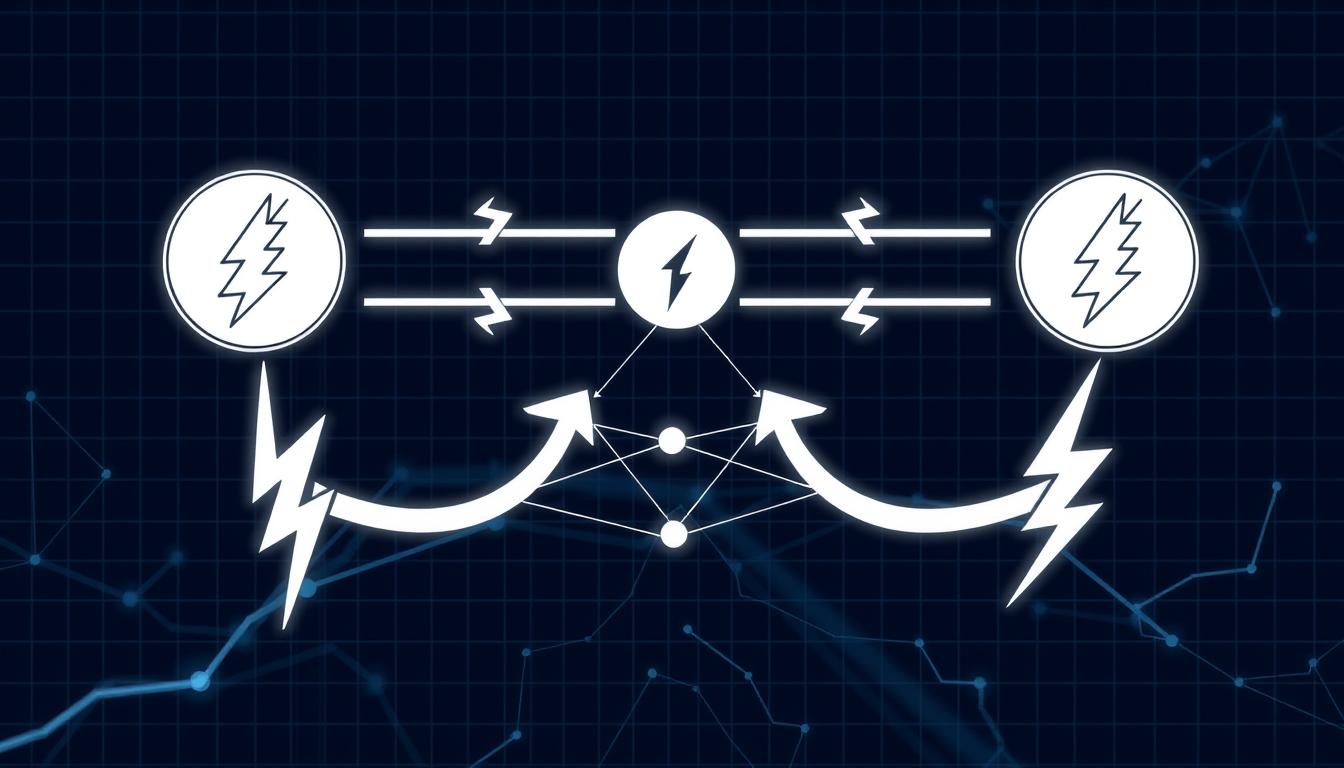Now Reading: Bitcoin Lightning Network: Scalability Solution Explained
- 01
Bitcoin Lightning Network: Scalability Solution Explained
Bitcoin Lightning Network: Scalability Solution Explained
In 2015, developers Tadge Dryja and Joseph Poon proposed a groundbreaking idea to solve a critical challenge: enabling faster, cheaper digital payments without compromising security. Their solution, now known as the Lightning Network, operates as a secondary framework built atop an existing blockchain system.

This layer-2 protocol creates private payment channels between users, allowing them to conduct transactions instantly and at minimal cost. By moving most activity off the primary chain, it reduces congestion while preserving the decentralized nature of the underlying technology.
The system supports millions of operations per second, rivaling traditional payment processors in speed. Unlike conventional methods, it maintains transparency and trustlessness through smart contracts. Everyday purchases like coffee or online services become practical, opening new possibilities for real-world adoption.
Key Takeaways
- Addresses scalability challenges through off-chain transaction channels
- Enables instant, low-cost payments for everyday use
- Maintains blockchain security and decentralization principles
- Supports exponentially higher throughput than base-layer systems
- Uses smart contracts to ensure trustless interactions
Understanding Bitcoin’s Scalability Challenges
Modern payment systems demand speed, but decentralized networks face a critical roadblock. The base layer of many digital currencies processes fewer than 10 transactions per second – a stark contrast to Visa’s 20,000+ capability. This bottleneck creates friction for everyday use, especially as adoption grows.

Throughput Limitations and Rising Costs
Every action on a decentralized ledger requires verification across multiple nodes. With blocks created every 10 minutes and limited storage capacity, competition for space escalates. During peak usage, confirmation delays stretch to hours while fees spike unpredictably. A $3 coffee purchase might incur $5 in processing costs.
Why Layer-2 Systems Became Essential
Traditional scaling methods like increasing block sizes risk centralization. Off-chain solutions emerged as the practical answer, enabling:
- Instant settlements between frequent transactors
- Fees reduced to fractions of a cent
- Capacity for millions of operations daily
These improvements address core issues without altering the underlying protocol’s security. By moving routine exchanges off the primary chain, systems maintain decentralization while achieving commercial viability.
Exploring the bitcoin lightning network and Its Core Mechanisms
Digital payment innovations often hinge on balancing speed with security. Layer-2 systems achieve this through unique architectures that prioritize efficiency while maintaining robust safeguards.
How Payment Channels Operate
Two participants create a shared wallet requiring dual approval for transfers. This collaborative account gets funded through an on-chain deposit, visible to all network participants.

Once active, users exchange value instantly through private balance adjustments. These updates bypass main network validation, enabling rapid microtransactions. Final settlements occur only when closing the channel, as explained in this network comparison guide.
Security and Multi-Signature Systems
The dual-key structure prevents unilateral fund access. Every balance change requires cryptographic proof from both parties, creating audit trails without third-party oversight. This model supports trustless collaboration between unfamiliar entities.
Smart Contracts and Automation
Preprogrammed rules manage fund distribution and dispute resolution. Conditions execute automatically when met, eliminating manual oversight. Users can set up specialized wallets to interact with these self-enforcing agreements seamlessly.
These mechanisms enable high-volume exchanges at negligible costs while preserving transactional integrity. The system’s design demonstrates how layered solutions can expand functionality without compromising core principles.
Benefits and Use Cases of Lightning Payments
Modern commerce demands speed and flexibility, qualities that traditional systems often struggle to deliver. Layer-2 solutions transform digital exchanges by enabling value transfers that feel instantaneous to users.

Instant Transactions and Micropayment Feasibility
Transactions settle in under two seconds – faster than card swipes. This speed enables real-time purchases like grabbing coffee without waiting for confirmations. Fees often measure fractions of a cent, making micro-transactions for small purchases practical for streaming services or pay-per-view articles.
Scalability improvements allow millions of operations per second. Retailers benefit from reliable point-of-sale systems boasting 99.7% success rates. Cross-border transfers become seamless, bypassing currency conversion delays.
Privacy enhancements occur naturally. Individual exchanges remain hidden until channels close, offering more discretion than transparent ledgers. Users enjoy:
- Fractional payments for gaming credits
- Instant tips for content creators
- Machine-to-machine payments in IoT ecosystems
These features position layer-2 systems as essential tools for modern financial interactions. They maintain security while unlocking possibilities once deemed impractical for decentralized networks.
Industry Adoption and Real-World Applications
Businesses worldwide are embracing layer-2 solutions to overcome traditional payment hurdles. From coffee shops to global corporations, this technology reshapes how value moves across borders and industries.
Case Studies: Retail and Cross-Border Payments
Quick-service restaurants like McDonald’s in El Salvador now accept instant payments through layer-2 systems. Shopify merchants process international orders faster using dollar and crypto settlements, reducing currency conversion delays.
Remittance platforms demonstrate the protocol’s social impact. Strike’s service slashes transfer fees for overseas workers, particularly in regions with limited banking access. Voltage data shows payment volume surging 2,424% since 2022.
Support by Major Players
Leading exchanges have integrated layer-2 functionality, serving millions of users. Gaming platforms drive 27% of transaction growth through in-game purchases. Social networks like Nostr enable 3.6 million micro-tips in six months.
Developers maintain over 16,400 nodes supporting $145 million in active channels. This infrastructure expansion reflects growing confidence in the protocol’s stability for everyday use.
Looking Ahead: The Future of Bitcoin Scalability
The evolution of payment systems now hinges on balancing innovation with accessibility. Developers are expanding layer-2 capabilities through tools like Loop for seamless fund transfers and Pool for optimized liquidity management. These solutions address initial setup complexities while supporting diverse assets through protocols like Taro.
New applications stretch beyond basic payments into gaming and decentralized finance. Interactive platforms leverage instant settlements for in-game purchases, while exchanges integrate the protocol to slash withdrawal fees. Over 16,000 nodes now secure $145 million in active channels, signaling growing trust in this infrastructure.
Security remains paramount as automated Watchtower services monitor for fraudulent activity. These systems penalize bad actors attempting to exploit offline users, creating safer environments for casual participants.
Despite progress, challenges like channel funding costs and technical barriers persist. Yet adoption metrics show steady growth, with transaction volumes increasing 2,424% since 2022. As developers refine node analytics and cross-chain compatibility, this scalability solution appears poised to support tomorrow’s digital economy.
FAQ
What problem does the Lightning Network solve?
It addresses blockchain congestion by enabling off-chain transactions through payment channels. This reduces fees, speeds up processing, and supports millions of transactions per second without overloading the base layer.
How do payment channels work?
Two parties open a multi-signature wallet to create a private channel. Funds are locked in, allowing instant transfers between them. Balances update automatically, and only final settlements are recorded on the blockchain.
Is the Lightning Network secure?
Yes. Transactions use smart contracts and cryptographic safeguards like hashed timelocks. Funds can’t be spent without mutual agreement, and users can force-close channels if a party acts maliciously.
Can I use it for micropayments like buying coffee?
Absolutely. Fees are fractions of a cent, making small purchases feasible. Retailers like Starbucks or local shops can accept payments instantly without worrying about high transaction costs.
Who supports this technology?
Major platforms like Kraken and Bitfinex integrate Lightning for deposits. Developers like Blockstream and Lightning Labs drive protocol upgrades. Countries like El Salvador also explore it for cross-border remittances.
What are the current limitations?
Liquidity management and channel balancing require user attention. Routing payments across multiple nodes can sometimes fail, though solutions like atomic multi-path payments aim to address this.
How does it compare to traditional payment systems?
Unlike Visa or PayPal, Lightning operates without intermediaries. Transactions settle instantly, and fees remain low regardless of transfer size. It’s also globally accessible, bypassing banking restrictions.












